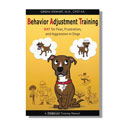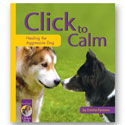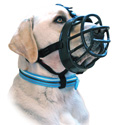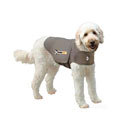People call many behaviors aggression, and talk about "treating" aggression as if it were a medical entity, like a staph infection. It's as if any display of symptoms confirms the existence of a full-blown case for which known treatments exist.
The archetypal event for me was the TV trainer who cornered and frightened a poodle puppy until it growled at him, and then told the owners the dog was a "loaded gun." There was a loaded gun on the scene, all right, but it wasn't the dog.
I've taken, in practice, to avoiding the term altogether and speaking of all agonistic behavior (the biological term for hostile or fearful displays) as manifestation of fear, with the correct response being a mix of reducing the stimulus, and reinforcing (clicking) more appropriate behaviors, calming signals definitely being among them, and then gradually reinstating the once-frightening stimulus.
Emma Parsons's dog Benny (a golden in my 1998 experimental class) was afraid of many things; I remember seeing him shrinking from a rubber door mat in the place where we worked, and spending some time with Emma clicking him into crossing it with tail up. Confidence in one area (or trained body language in one area or situation) can then leak into other areas, giving you something to click.
I'm presently doing something similar with a horse, who gets antsy and excited in any new place, even just being led from the barn. It's fear...of whom or what in her history I don't know or care—and has on occasion escalated into "aggression," including nipping, pawing the ground, fighting the lead line, and even bucking and bolting. Lower your head, relax your ears, click. Can you do it here? Yes. Can you do it there? No? Back up a step, we start again. As Alexandra Kurland (author of Clicker Training for Your Horse ) says, the horse is showing you what it doesn't know yet. Aggression-like behavior is usually just dogs doing the same. IMHO [in my humble opinion].








Clickers
I think that you can also get special clickers for dogs with sensitive ears, I have the new I-Click and it is definately quieter than the other clicker I had and on the flip side also encourages my dog to listen more!
terrified of click
My dog is scared of the clicking. She has fear aggression or behaviors and when I "reward" her for being brave (smelling a new object) by clicking, she gets MUCH MUCH MUCH more afraid of the object than she was before. Can you give me some idea of how I can make this system work with a dog who cannot tolerate the click, or who reads the loud and sharp noise as a threat?
You could muffle the click
You could muffle the click somehow (tape over the metal bit of the clicker, or put the clicker in a sock or glove, for instance), or use one of those pens you have to push down to use, which makes a soft click. If she's still scared of that, look for another sound-making object, or if all else fails use a word (one you can say quickly and don't use in every day life) or sound you can make with your mouth. Hope this helps!:)
Post new comment